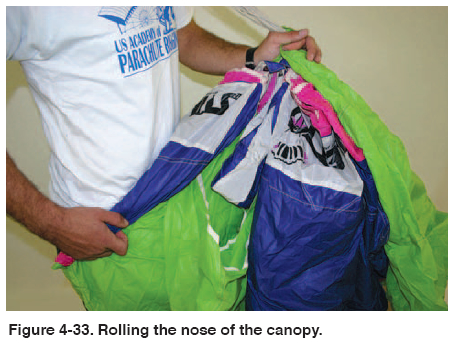Chapter 4
DEPLOYMENT AND INFLATION CHARACTERISTICS
Main canopies have changed dramatically over the last
several years and, consequently, different opening
problems have emerged. One of the most common
problems encountered is hard openings. The most
effective method employed to reduce hard openings is
to roll the nose of the canopy to close off the openings
in the leading edge during the initial inflation process.
This rolling technique varies from a single roll to several
rolls. Figure 4-33 shows this technique. If this does
not solve the opening problem, riggers should contact
the manufacturer for advice. Most manufacturers are
very cooperative and have considerable expertise in
working with their products.

In the event the manufacturer cannot resolve the problem,
it may be necessary for the rigger to modify the
slider size, or deployment brake settings. Of these
options, the easiest to do is to change the brake setting.
Reducing the brake setting results in less pressure on
the canopy during opening, thereby reducing the opening
force. The negative effect of reducing the brake setting
is an increase in opening surge. The new brake
setting must find the balance of these results that best
fit the user. If changing the brake setting does not work,
then the rigger may wish to increase the size of the
slider to slow the openings. This usually means replacing
the slider with a larger one. This has the effect of
increasing the drag on the slider and restricting the
canopy inflation.
As canopies age and accumulate substantial jumps on
them, many begin to develop slow openings, commonly
known as “sniveling.” If the canopy was originally
packed with the nose rolled, reducing the number
of rolls may speed up the openings. However, many
times the slow openings are due to other causes. One
of the most common is the canopy getting out of trim
due to the stretch of the suspension lines. The rigger
should check the trim of the canopy against the manufacturer’s
specifications and either re-trim the canopy or re-line it. This has a pronounced effect of improving
the openings as well as the flying characteristics, particularly
on canopies made from zero porosity (ZP)
fabric.
The effect on fabric that originally had a porosity (permeability)
of 0-3 cfm or 0-5 cfm, such as PIA-C-
44378, may not be as dramatic. With these canopies,
changing the brake setting and increasing it by pulling
down the tail will speed up the inflation of the canopy.
The rigger must be careful not to set the brakes so
deeply as to place the canopy in a stall during opening.
If this does not work, then decreasing the size of the
slider or the fabric type of the slider may help speed up
the openings. Some of these problems, while appearing
to be main canopy related, are traceable to other
components of the parachute system such as the
deployment bag, bridle, or pilot chute.
MAIN PILOT CHUTE
Hand deploy pilot chutes are generally made from
either the PIA-C-44378 (F-111) fabric or more commonly,
zero porosity (ZP) fabric. The PIA-C-44378
fabric begins as a very low porosity fabric but as it is
used, the permeability increases. As this happens, the
drag of the pilot chute decreases. Consequently, the
ability of the pilot chute to lift the weight of the canopy
decreases and the speed of the opening is affected.
Experience has shown that pilot chutes made from this
type of fabric exhibit a decrease in performance at
around 500 jumps under normal use.
Pilot chutes made from the ZP fabric last considerably
longer than those made from F-111. However, there
has been some disagreement concerning the use of the
two different fabrics in pilot chutes. One canopy manufacturer
advocates the use of F-111 type fabric only.
They believe the ZP fabric contributes to hard openings.
Most parachutists like ZP pilot chutes because
they last longer.
The size of the pilot chute has a direct correlation to
the type of opening experienced. In the early days of
hand deploy chutes, a 36" F-111 pilot chute was standard
on most systems. As the canopies became smaller
and lighter, pilot chutes became smaller as well. Today,
24-26", 30", and 33" pilot chutes are all common.
Several factors dictate the size of the pilot chute used.
The first is the weight of the canopy. Another factor is
the main container closing configuration. Some systems
are designed to hold the deployment bag so securely that
it literally has to be jerked from the container. This type
requires a larger pilot chute than the type of container
that allows unrestricted extraction of the bag. This same
problem can develop when an individual packs an oversized
main canopy into the main container. Usually, a
larger deployment bag is needed to hold the additional volume. When the bag is forcibly stuffed into the container,
the bag can be restricted from being pulled
smoothly from the container.
If the pilot chute is too small, a pilot chute in tow can
result. If the parachutist puts a larger pilot chute on the
system, the bag can be extracted from the container,
but the increased size of the pilot chute contributes to
increased snatch force during the opening sequence.
This results in perceived hard openings. Therefore, the
size of the pilot chute and the deployment bag can have
considerable effect on the opening characteristics of
the main parachute.
| 
